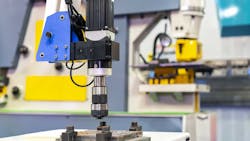NFPA Presenting Fluid Power Conference Sessions at Automate 2025
The National Fluid Power Association (NFPA) has announced it will host three educational sessions during Automate 2025. Automate will take place May 12-15 in Detroit, MI, and is considered one of the largest events focused on industrial automation and robotics technologies.
Hydraulics and pneumatics play important roles in various automation systems. As such, the NFPA sessions will provide an opportunity for attendees to learn about technological developments taking place in fluid power and how those can benefit their automation solutions.
Greater digitalization and integration with electric technologies are just some of the ways fluid power systems are evolving to meet the needs of current and future industrial automation applications. These and other topics will be among those discussed during the NFPA-hosted sessions, all of which take place on May 14 as part of Automate’s educational program.
The National Fluid Power Association (NFPA) continues to increase its partnerships with various trade shows relevant to the hydraulics and pneumatics industry. It is doing so to help enhance educational opportunities for those working in fluid power as well as spotlight the range of applications and industries in which hydraulic and pneumatic technologies are utilized.
In August, NFPA will once again host a 2-day conference as part of iVT Expo 2025. This event is designed specifically for those designing heavy-duty mobile equipment, one of the largest customer segments for fluid power.
And although there will be no IFPE as part of CONEXPO-CON/AGG in 2026, the association plans to host an advanced hydraulics conference as part of the event — one of the largest for the construction and mining equipment industries. This partnership will again provide an educational opportunity for those developing fluid power technologies for one of the industry’s largest customer markets.
Per NFPA, the following sessions have been confirmed:
Emerging Technologies and Architectures of Automated Systems with Integrated Functional Safety at 1:30-2:15 p.m.
- Presented by: Linda Caron, Global Product Sales Manager, Factory Automation & Machinery Safety, Parker Hannifin
- Session Summary: Emerging Technologies have added a degree of sophistication to the plant floor. Collective wiring has migrated to networked communication. Different topologies can be used to connect devices such as IO-Link and the integration of safety circuits both hardwired and over network bring about new challenges. Together we explore the integration of emerging technology and the expansion of functional safety to fluid power components.
Pneumatic Operational Improvement via Digitalization at 2:30-3:15 p.m.
- Presented by: Frank Latino, Product Manager, Festo
- Session Summary: Leveraging digital technologies such as digital communications, machine learning, artificial intelligence, Internet of Things, and Edge Computing can improve the operation of pneumatic systems. Specifically, the maintenance process, energy consumption, and machine safety. Machines must be digitally connected to access data from smart devices to achieve this. We will discuss the use of these technologies. The basis will be on ethernet and IO-Link. We will touch on performance characteristics such as speed, capacity, and security. We will then look at use cases that will provide benefits to machine builders, including networked safety, sustainability, and predictive analysis.
The Electrification of Industrial Hydraulics – A Glimpse into the Future (Now) at 3:30-4:15 p.m.
- Presented by: Christopher Parisse, Senior Controls Product Engineer, Bosch Rexroth
- Session Summary: When you think about traditional hydraulic systems, the first thing that may come to mind is a loud energy hogging oily solution. These types of machines are a thing of the past thanks to the harmony of electrification with hydraulic systems. This transition is driven by advancements in hydraulic motion control, variable speed drives and clever system design, enabling the replacement of conventional hydraulic components with electro-hydraulic alternatives. Electrified hydraulic systems offer benefits such as improved energy efficiency, reduced emissions, lower maintenance requirements, and enhanced system controllability. Applications span across industries such as industrial automation, heavy manufacturing, plastics processing, machine tool and more where the demand for cleaner and more efficient power solutions continues to grow. During this presentation we will discuss the concepts that will provide benefit to machine builders, including the integration of VFDs and servo drives in hydraulic applications, a different concept of a hydraulic power unit, and the benefits of power density with hydraulics.
About the Author
Sara Jensen
Executive Editor, Power & Motion
Sara Jensen is executive editor of Power & Motion, directing expanded coverage into the modern fluid power space, as well as mechatronic and smart technologies. She has over 15 years of publishing experience. Prior to Power & Motion she spent 11 years with a trade publication for engineers of heavy-duty equipment, the last 3 of which were as the editor and brand lead. Over the course of her time in the B2B industry, Sara has gained an extensive knowledge of various heavy-duty equipment industries — including construction, agriculture, mining and on-road trucks —along with the systems and market trends which impact them such as fluid power and electronic motion control technologies.
You can follow Sara and Power & Motion via the following social media handles:
X (formerly Twitter): @TechnlgyEditor and @PowerMotionTech
LinkedIn: @SaraJensen and @Power&Motion
Facebook: @PowerMotionTech

Leaders relevant to this article:

